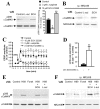Abnormal Ca2+-calmodulin-dependent protein kinase II function mediates synaptic and motor deficits in experimental parkinsonism
- PMID: 15190099
- PMCID: PMC6729313
- DOI: 10.1523/JNEUROSCI.1224-04.2004
Abnormal Ca2+-calmodulin-dependent protein kinase II function mediates synaptic and motor deficits in experimental parkinsonism
Abstract
The NMDA receptor complex represents a key molecular element in the pathogenesis of long-term synaptic changes and motor abnormalities in Parkinson's disease (PD). Here we show that NMDA receptor 1 (NR1) subunit and postsynaptic density (PSD)-95 protein levels are selectively reduced in the PSD of dopamine (DA)-denervated striata. These effects are accompanied by an increase in striatal levels of alphaCa2+-calmodulin-dependent protein kinase II (alphaCaMKII) autophosphorylation, along with a higher recruitment of activated alphaCaMKII to the regulatory NMDA receptor NR2A-NR2B subunits. Acute treatment of striatal slices with R(+)-7-chloro-8-hydroxy-3-methyl-1-phenyl-2,3,4,5-tetrahydro-1H-3-benzazepine hydrochloride, but not with l-sulpiride, mimicked the effect of DA denervation on both alphaCaMKII autophosphorylation and corticostriatal synaptic plasticity. In addition to normalizing alphaCaMKII autophosphorylation levels as well as assembly and anchoring of the kinase to the NMDA receptor complex, intrastriatal administration of the CaMKII inhibitors KN-93 (N-[2-[[[3-(4-chlorophenyl)-2-propenyl]methylamino]methyl]phenyl]-N-(2-hydroxyethyl)-4-methoxybenzenesulfonamide) and antennapedia autocamtide-related inhibitory peptide II is able to reverse both the alterations in corticostriatal synaptic plasticity and the deficits in spontaneous motor behavior that are found in an animal model of PD. The same beneficial effects are produced by a regimen of l-3,4-dihydroxyphenylalanine (L-DOPA) treatment, which is able to normalize alphaCaMKII autophosphorylation. These data indicate that abnormal alphaCaMKII autophosphorylation plays a causal role in the alterations of striatal plasticity and motor behavior that follow DA denervation. Normalization of CaMKII activity may be an important underlying mechanism of the therapeutic action of L-DOPA in PD.
Figures





Similar articles
-
Effect of dopamine denervation and dopamine agonist administration on serine phosphorylation of striatal NMDA receptor subunits.Brain Res. 1999 Mar 13;821(2):433-42. doi: 10.1016/s0006-8993(99)01121-x. Brain Res. 1999. PMID: 10064831
-
A critical interaction between NR2B and MAGUK in L-DOPA induced dyskinesia.J Neurosci. 2006 Mar 15;26(11):2914-22. doi: 10.1523/JNEUROSCI.5326-05.2006. J Neurosci. 2006. PMID: 16540568 Free PMC article.
-
Hippocampal synaptic plasticity involves competition between Ca2+/calmodulin-dependent protein kinase II and postsynaptic density 95 for binding to the NR2A subunit of the NMDA receptor.J Neurosci. 2001 Mar 1;21(5):1501-9. doi: 10.1523/JNEUROSCI.21-05-01501.2001. J Neurosci. 2001. PMID: 11222640 Free PMC article.
-
Synaptic dysfunction in Parkinson's disease.Adv Exp Med Biol. 2012;970:553-72. doi: 10.1007/978-3-7091-0932-8_24. Adv Exp Med Biol. 2012. PMID: 22351072 Review.
-
Striatal synaptic changes in experimental parkinsonism: role of NMDA receptor trafficking in PSD.Parkinsonism Relat Disord. 2008;14 Suppl 2:S145-9. doi: 10.1016/j.parkreldis.2008.04.019. Epub 2008 Jun 25. Parkinsonism Relat Disord. 2008. PMID: 18583173 Review.
Cited by
-
Modulation of the glutamatergic transmission by Dopamine: a focus on Parkinson, Huntington and Addiction diseases.Front Cell Neurosci. 2015 Mar 2;9:25. doi: 10.3389/fncel.2015.00025. eCollection 2015. Front Cell Neurosci. 2015. PMID: 25784855 Free PMC article. Review.
-
Striatal synaptic bioenergetic and autophagic decline in premotor experimental parkinsonism.Brain. 2022 Jun 30;145(6):2092-2107. doi: 10.1093/brain/awac087. Brain. 2022. PMID: 35245368 Free PMC article.
-
The amyloid-β oligomer Aβ*56 induces specific alterations in neuronal signaling that lead to tau phosphorylation and aggregation.Sci Signal. 2017 May 9;10(478):eaal2021. doi: 10.1126/scisignal.aal2021. Sci Signal. 2017. PMID: 28487416 Free PMC article.
-
Interactions of CaMKII with dopamine D2 receptors: roles in levodopa-induced dyskinesia in 6-hydroxydopamine lesioned Parkinson's rats.Sci Rep. 2014 Oct 29;4:6811. doi: 10.1038/srep06811. Sci Rep. 2014. PMID: 25351365 Free PMC article.
-
Epigenetic Mechanisms Shaping Spine Regulation: Unveiling the Role of Cytoskeletal Dynamics and Localized Protein Synthesis.Mol Neurobiol. 2025 Jun 3. doi: 10.1007/s12035-025-05045-7. Online ahead of print. Mol Neurobiol. 2025. PMID: 40459714 Review.
References
-
- Bortolotto ZA, Collingridge GL (1998) Involvement of calcium/calmodulin-dependent protein kinases in the setting of a molecular switch involved in hippocampal LTP. Neuropharmacology 37: 535-544. - PubMed
-
- Calabresi P, Pisani A, Mercuri NB, Bernardi G (1992) Long term potentiation in the striatum unmasked by removing the voltage-dependent magnesium block of NMDA receptor channels. Eur J Neurosci 4: 929-935. - PubMed
-
- Calabresi P, Mercuri NB, Sancesario G, Bernardi G (1993) Electrophysiology of dopamine-denervated striatal neurons: implications for Parkinson's disease. Brain 116: 433-452. - PubMed
-
- Calabresi P, Pisani A, Mercuri NB, Bernardi G (1996) The corticostriatal projection: from synaptic plasticity to dysfunctions of the basal ganglia. Trends Neurosci 19: 19-24. - PubMed
Publication types
MeSH terms
Substances
Grants and funding
LinkOut - more resources
Full Text Sources
Miscellaneous
